The Integration of Field Effect Transistors to Microfluidic Devices
Abstract
1. Introduction
2. Basic Principles Involved in the Operation of Field Effect Transistors
3. Field Effect-Based Sensors Integrated into Microfluidic Chips: Current Progress
3.1. Integrated Systems for Simultaneous Detections and Point of Care
3.1.1. Indium Gallium-Zinc Oxide Transistors Integrated into Microfluidic Chips
3.1.2. Integrated Flexible/Wearable FETs
3.1.3. Organic FETs
3.2. Devices with Non-Electrical Counterparts
3.3. Chloride Detection Devices
3.4. Other Applications
4. Conclusions
Author Contributions
Funding
Data Availability Statement
Acknowledgments
Conflicts of Interest
References
- Skoog, D.A.; West, D.M.; Holler, F.J.; Crouch, S.R. Fundamentals of Analytical Chemistry, 9th ed.; Thomson Brooks/Cole: Pacific Grove, CA, USA, 2013. [Google Scholar]
- Swaminathan, R.; Chitra Devi, M.; Rajendran, L.; Venugopal, K. Sensitivity and resistance of amperometric biosensors in substrate inhibition processes. J. Electroanal. Chem. 2021, 895, 115527. [Google Scholar] [CrossRef]
- Ballantine, D.; Martin, S.; Ricco, A.; Frye, G.; Wohltjen, H.; White, R.; Zellers, E. Chapter 5—Chemical and Biological Sensors. In Acoustic Wave Sensors; Applications of Modern Acoustics; Academic Press: Burlington, VT, Canada, 1997; pp. 222–330. [Google Scholar] [CrossRef]
- Nogueira Pedroza Dias Mello, H.J.; Bueno, P.R.; Mulato, M. Comparing glucose and urea enzymatic electrochemical and optical biosensors based on polyaniline thin films. Anal. Methods 2020, 12, 4199–4210. [Google Scholar] [CrossRef] [PubMed]
- Chiang, J.L.; Shang, Y.G.; Yadlapalli, B.K.; Yu, F.P.; Wuu, D.S. Ga2O3 nanorod-based extended-gate field-effect transistors for pH sensing. Mater. Sci. Eng. B 2022, 276, 115542. [Google Scholar] [CrossRef]
- Pan, T.M.; Wang, C.W.; Weng, W.C.; Lai, C.C.; Lu, Y.Y.; Wang, C.Y.; Hsieh, I.C.; Wen, M.S. Rapid and label-free detection of the troponin in human serum by a TiN-based extended-gate field-effect transistor biosensor. Biosens. Bioelectron. 2022, 201, 113977. [Google Scholar] [CrossRef] [PubMed]
- Mello, H.J.N.P.D.; Bachour Junior, B.; Mulato, M. Polyaniline-based field effect transistor for DNA/RNA biomarker sensing: Comparison to electrochemical impedance and inorganic layer. Sens. Actuators A Phys. 2021, 318, 112481. [Google Scholar] [CrossRef]
- Nur Nasyifa, M.M.; Ruslinda, A.R.; Abdul Halim, N.H.; Zainol Abidin, A.S.; Mohd Faudzi, F.N.; Ahmad, N.A.; Lockman, Z.; Rezek, B.; Kromka, A.; Gopinath, S.C. Immuno-probed graphene nanoplatelets on electrolyte-gated field-effect transistor for stable cortisol quantification in serum. J. Taiwan Inst. Chem. Eng. 2020, 117, 10–18. [Google Scholar] [CrossRef]
- Yu, J.; Gao, G.; Sun, B.; Liang, L.; Shen, Q.; Zhang, Y.; Cao, H. Optimization of sensing-pad functionalizing strategy toward separative extended-gate FET biosensors for PSA detection. J. Pharm. Biomed. Anal. 2022, 211, 114597. [Google Scholar] [CrossRef]
- Ali, A.M.A.; Ahmed, N.M.; Kabir, N.A.; Almessiere, M.A. Multilayer ZnO/Pb/G thin film based extended gate field effect transistor for low dose gamma irradiation detection. Nucl. Instrum. Methods Phys. Res. Sect. A Accel. Spectrometers Detect. Assoc. Equip. 2021, 987, 164833. [Google Scholar] [CrossRef]
- Krátká, M.; Cermák, J.; Vachelová, J.; Davídková, M.; Romanyuk, N.; Kromka, A.; Rezek, B. Gamma radiation effects on diamond field-effect biosensors with fibroblasts and extracellular matrix. Colloids Surf. B Biointerfaces 2021, 204, 111689. [Google Scholar] [CrossRef]
- Das, M.; Chakraborty, T.; Lin, C.Y.; Lin, R.M.; Kao, C.H. Screen-printed Ga2O3 thin film derived from liquid metal employed in highly sensitive pH and non-enzymatic glucose recognition. Mater. Chem. Phys. 2022, 278, 125652. [Google Scholar] [CrossRef]
- Si, H.; Pan, N.; Zhang, X.; Liao, J.; Rumyantseva, M.; Gaskov, A.; Lin, S. A real-time on-line photoelectrochemical sensor toward chemical oxygen demand determination based on field-effect transistor using an extended gate with 3D TiO2 nanotube arrays. Sens. Actuators B Chem. 2019, 289, 106–113. [Google Scholar] [CrossRef]
- Singh, N.K.; Thungon, P.D.; Estrela, P.; Goswami, P. Development of an aptamer-based field effect transistor biosensor for quantitative detection of Plasmodium falciparum glutamate dehydrogenase in serum samples. Biosens. Bioelectron. 2019, 123, 30–35. [Google Scholar] [CrossRef] [PubMed]
- Fernandes, E.; Cabral, P.D.; Campos, R.; Machado, G.; Cerqueira, M.F.; Sousa, C.; Freitas, P.P.; Borme, J.; Petrovykh, D.Y.; Alpuim, P. Functionalization of single-layer graphene for immunoassays. Appl. Surf. Sci. 2019, 480, 709–716. [Google Scholar] [CrossRef]
- Palit, S.; Singh, K.; Lou, B.S.; Her, J.L.; Pang, S.T.; Pan, T.M. Ultrasensitive dopamine detection of indium-zinc oxide on PET flexible based extended-gate field-effect transistor. Sens. Actuators B Chem. 2020, 310, 127850. [Google Scholar] [CrossRef]
- Niu, P.; Jiang, J.; Liu, K.; Wang, S.; Jing, J.; Xu, T.; Wang, T.; Liu, Y.; Liu, T. Fiber-integrated WGM optofluidic chip enhanced by microwave photonic analyzer for cardiac biomarker detection with ultra-high resolution. Biosens. Bioelectron. 2022, 208, 114238. [Google Scholar] [CrossRef] [PubMed]
- Sinha, A.; Tai, T.Y.; Li, K.H.; Gopinathan, P.; Chung, Y.D.; Sarangadharan, I.; Ma, H.P.; Huang, P.C.; Shiesh, S.C.; Wang, Y.L.; et al. An integrated microfluidic system with field-effect-transistor sensor arrays for detecting multiple cardiovascular biomarkers from clinical samples. Biosens. Bioelectron. 2019, 129, 155–163. [Google Scholar] [CrossRef]
- Laliberte, K.; Scott, P.; Khan, N.I.; Mahmud, M.S.; Song, E. A wearable graphene transistor-based biosensor for monitoring IL-6 biomarker. Microelectron. Eng. 2022, 262, 111835. [Google Scholar] [CrossRef]
- Song, P.; Fu, H.; Wang, Y.; Chen, C.; Ou, P.; Rashid, R.T.; Duan, S.; Song, J.; Mi, Z.; Liu, X. A microfluidic field-effect transistor biosensor with rolled-up indium nitride microtubes. Biosens. Bioelectron. 2021, 190, 113264. [Google Scholar] [CrossRef]
- Chou, C.H.; Lim, J.C.; Lai, Y.H.; Chen, Y.T.; Lo, Y.H.; Huang, J.J. Characterizations of protein-ligand reaction kinetics by transistor-microfluidic integrated sensors. Anal. Chim. Acta 2020, 1110, 1–10. [Google Scholar] [CrossRef]
- Chen, T.Y.; Yang, T.H.; Wu, N.T.; Chen, Y.T.; Huang, J.J. Transient analysis of streptavidin-biotin complex detection using an IGZO thin film transistor-based biosensor integrated with a microfluidic channel. Sens. Actuators B Chem. 2017, 244, 642–648. [Google Scholar] [CrossRef]
- Fu, Y.; Willander, M. Carrier transport characteristics of small-size field effect transistors. Phys. E Low-Dimens. Syst. Nanostructures 1999, 4, 149–155. [Google Scholar] [CrossRef]
- Pullano, S.A.; Critello, C.D.; Mahbub, I.; Tasneem, N.T.; Shamsir, S.; Islam, S.K.; Greco, M.; Fiorillo, A.S. EGFET-Based Sensors for Bioanalytical Applications: A Review. Sensors 2018, 18, 4042. [Google Scholar] [CrossRef] [PubMed]
- Mello, H.J.N.P.D.; Mulato, M. Sensores Químicos com Transdução Microeletrônica e Ótica Utilizando Polianilina Nanoestruturada. Master’s Dissertation, Universidade de São Paulo, São Paulo, Brazil, 2014. [Google Scholar]
- Swart, J.W. Semicondutores: Fundamentos Técnicos, Técnicas e Aplicações, 1st ed.; UNICAMP: São Paulo, Brazil, 2008. [Google Scholar]
- Bhattacharyya, I.M.; Cohen, S.; Shalabny, A.; Bashouti, M.; Akabayov, B.; Shalev, G. Specific and label-free immunosensing of protein-protein interactions with silicon-based immunoFETs. Biosens. Bioelectron. 2019, 132, 143–161. [Google Scholar] [CrossRef]
- Sedra, A.S.; Smith, K.C. Microelectronic Circuits, 5th ed.; Oxford University Press: Oxford, UK, 2004. [Google Scholar]
- Jung, G.; Hong, Y.; Hong, S.; Jang, D.; Jeong, Y.; Shin, W.; Park, J.; Kim, D.; Jeong, C.B.; Kim, D.U.; et al. A low-power embedded poly-Si micro-heater for gas sensor platform based on a FET transducer and its application for NO2 sensing. Sens. Actuators B Chem. 2021, 334, 129642. [Google Scholar] [CrossRef]
- Shin, W.; Jung, G.; Hong, S.; Jeong, Y.; Park, J.; Kim, D.; Park, B.G.; Lee, J.H. Optimization of channel structure and bias condition for signal-to-noise ratio improvement in Si-based FET-type gas sensor with horizontal floating-gate. Sens. Actuators B Chem. 2022, 357, 131398. [Google Scholar] [CrossRef]
- Sadighbayan, D.; Hasanzadeh, M.; Ghafar-Zadeh, E. Biosensing based on field-effect transistors (FET): Recent progress and challenges. TrAC Trends Anal. Chem. 2020, 133, 116067. [Google Scholar] [CrossRef]
- Hess, K.; Register, L.; McMahon, W.; Tuttle, B.; Aktas, O.; Ravaioli, U.; Lyding, J.; Kizilyalli, I. Theory of channel hot-carrier degradation in MOSFETs. Phys. B Condens. Matter 1999, 272, 527–531. [Google Scholar] [CrossRef]
- Pan, T.M.; Huang, Y.S.; Her, J.L. Super-Nernstian pH sensitivity of TbTaO4 sensing film for a solid-state pH sensor. Mater. Chem. Phys. 2022, 275, 125284. [Google Scholar] [CrossRef]
- Chou, J.C.; Liao, L.P. Study on pH at the point of zero charge of TiO2 pH ion-sensitive field effect transistor made by the sputtering method. Thin Solid Film. 2005, 476, 157–161. [Google Scholar] [CrossRef]
- Wang, C.W.; Pan, T.M. Structural properties and sensing performances of CoNxOy ceramic films for EGFET pH sensors. Ceram. Int. 2021, 47, 25440–25448. [Google Scholar] [CrossRef]
- Van der spiegel, J.; Lauks, I.; Chan, P.; Babic, D. The extended gate chemically sensitive field effect transistor as multi-species microprobe. Sens. Actuators 1983, 4, 291–298. [Google Scholar] [CrossRef]
- Kus, M.; Alic, T.Y.; Kirbiyik, C.; Baslak, C.; Kara, K.; Kara, D.A. Chapter 24—Synthesis of Nanoparticles. In Handbook of Nanomaterials for Industrial Applications; Mustansar Hussain, C., Ed.; Micro and Nano Technologies; Elsevier: Amsterdam, The Netherlands, 2018; pp. 392–429. [Google Scholar] [CrossRef]
- Zehra, N.; Adil, L.R.; Tanwar, A.S.; Mondal, S.; Krishnan Iyer, P. Chapter 11—Thin-film devices for chemical, biological, and diagnostic applications. In Chemical Solution Synthesis for Materials Design and Thin Film Device Applications; Das, S., Dhara, S., Eds.; Elsevier: Amsterdam, The Netherlands, 2021; pp. 369–405. [Google Scholar] [CrossRef]
- Haque, A.; Khan, M.S.; Lau, M.T.; Li, Z.; Raithby, P.R.; Wong, W.Y. 14.03—Conjugated Poly(metalla-ynes). In Comprehensive Organometallic Chemistry IV; Parkin, G., Meyer, K., O’hare, D., Eds.; Elsevier: Oxford, UK, 2022; pp. 23–70. [Google Scholar] [CrossRef]
- Cheng, Y.; Chen, K.S.; Meyer, N.L.; Yuan, J.; Hirst, L.S.; Chase, P.B.; Xiong, P. Functionalized SnO2 nanobelt field-effect transistor sensors for label-free detection of cardiac troponin. Biosens. Bioelectron. 2011, 26, 4538–4544. [Google Scholar] [CrossRef] [PubMed]
- Jiang, J.; Pendse, S.; Zhang, L.; Shi, J. Strain related new sciences and devices in low-dimensional binary oxides. Nano Energy 2022, 104, 107917. [Google Scholar] [CrossRef]
- Han, Z.; Lu, J.; Yin, C.; Lai, P.; Zhuang, W.; Li, L.; Wang, J.; Zhang, L.; Guo, X. Composition, microstructure, and phase evolution of 17-4PH stainless steel with a work-hardened layer in the low-temperature plasma nitriding process. Surf. Coat. Technol. 2022, 451, 128950. [Google Scholar] [CrossRef]
- Mingolo, N.; Tschiptschin, A.; Pinedo, C. On the formation of expanded austenite during plasma nitriding of an AISI 316L austenitic stainless steel. Surf. Coat. Technol. 2006, 201, 4215–4218. [Google Scholar] [CrossRef]
- Gao, J.; Wang, C.; Chu, Y.; Han, Y.; Gao, Y.; Wang, Y.; Wang, C.; Liu, H.; Han, L.; Zhang, Y. Graphene oxide-graphene Van der Waals heterostructure transistor biosensor for SARS-CoV-2 protein detection. Talanta 2022, 240, 123197. [Google Scholar] [CrossRef]
- Hwang, Y.; Lee, J.; Heo, S.J.; Hong, N.; Lee, J.; Jang, J.E.; Kang, H. a-IGZO thin-film transistors with transparent ultrathin Al/Ag bilayer source and drain for active neural interfaces. Mater. Sci. Semicond. Process. 2023, 154, 107188. [Google Scholar] [CrossRef]
- Mandal, N.; Pakira, V.; Samanta, N.; Das, N.; Chakraborty, S.; Pramanick, B.; RoyChaudhuri, C. PSA detection using label free graphene FET with coplanar electrodes based microfluidic point of care diagnostic device. Talanta 2021, 222, 121581. [Google Scholar] [CrossRef]
- Purwidyantri, A.; Ipatov, A.; Domingues, T.; Borme, J.; Martins, M.; Alpuim, P.; Prado, M. Programmable graphene-based microfluidic sensor for DNA detection. Sens. Actuators B Chem. 2022, 367, 132044. [Google Scholar] [CrossRef]
- Seo, G.; Lee, G.; Kim, M.J.; Baek, S.H.; Choi, M.; Ku, K.B.; Lee, C.S.; Jun, S.; Park, D.; Kim, H.G.; et al. Rapid Detection of COVID-19 Causative Virus (SARS-CoV-2) in Human Nasopharyngeal Swab Specimens Using Field-Effect Transistor-Based Biosensor. Am. Chem. Soc. 2020, 14, 5135–5142. [Google Scholar] [CrossRef]
- Wei, J.; Zhao, Z.; Lan, K.; Wang, Z.; Qin, G.; Chen, R. Highly sensitive detection of multiple proteins from single cells by MoS2-FET biosensors. Talanta 2022, 236, 122839. [Google Scholar] [CrossRef] [PubMed]
- Song, P.; Ou, P.; Wang, Y.; Yuan, H.; Duan, S.; Chen, L.; Fu, H.; Song, J.; Liu, X. An ultrasensitive FET biosensor based on vertically aligned MoS2 nanolayers with abundant surface active sites. Anal. Chim. Acta 2023, 1252, 341036. [Google Scholar] [CrossRef] [PubMed]
- Jain, N.; Sharma, S.K.; Kumawat, R.; Jain, A.; Lakhawat, S. Influence of high-k dielectric material on the electrical performance of a-IGZO Thin Film Transistor. Mater. Today Proc. 2022, 66, 3553–3558. [Google Scholar] [CrossRef]
- Yoo, J.; Hong, J.H.; Kim, H.; Kim, D.; Lee, C.K.; Kim, M.; Byun, C.; Choi, B. High-pressure H2O post-annealing for improving reliability of LTPS and a-IGZO thin-film transistors within a coplanar structure. Mater. Sci. Semicond. Process. 2023, 157, 107299. [Google Scholar] [CrossRef]
- Chae, M.S.; Park, J.H.; Son, H.W.; Hwang, K.S.; Kim, T.G. IGZO-based electrolyte-gated field-effect transistor for in situ biological sensing platform. Sens. Actuators B Chem. 2018, 262, 876–883. [Google Scholar] [CrossRef]
- Kumar, N.; Wang, W.; Ortiz-Marquez, J.C.; Catalano, M.; Gray, M.; Biglari, N.; Hikari, K.; Ling, X.; Gao, J.; van Opijnen, T.; et al. Dielectrophoresis assisted rapid, selective and single cell detection of antibiotic resistant bacteria with G-FETs. Biosens. Bioelectron. 2020, 156, 112123. [Google Scholar] [CrossRef]
- Kim, H.E.; Schuck, A.; Oh, J.; Jung, K.M.; Kim, Y.S. Improving the neutrality point uniformity for SG-FET-based DNA sensor. Solid-State Electron. 2020, 167, 107750. [Google Scholar] [CrossRef]
- Koklu, A.; Ohayon, D.; Wustoni, S.; Hama, A.; Chen, X.; McCulloch, I.; Inal, S. Microfluidics integrated n-type organic electrochemical transistor for metabolite sensing. Sens. Actuators B Chem. 2021, 329, 129251. [Google Scholar] [CrossRef]
- Ricci, S.; Casalini, S.; Parkula, V.; Selvaraj, M.; Saygin, G.D.; Greco, P.; Biscarini, F.; Mas-Torrent, M. Label-free immunodetection of -synuclein by using a microfluidics coplanar electrolyte-gated organic field-effect transistor. Biosens. Bioelectron. 2020, 167, 112433. [Google Scholar] [CrossRef]
- Kim, D.S.; Park, J.E.; Shin, J.K.; Kim, P.K.; Lim, G.; Shoji, S. An extended gate FET-based biosensor integrated with a Si microfluidic channel for detection of protein complexes. Sens. Actuators B Chem. 2006, 117, 488–494. [Google Scholar] [CrossRef]
- Liu, W.; Zhang, H.; Zhao, H.; Tang, Z.; Wang, Y.; Sun, C.; Pang, W.; Duan, X. Comparative analysis of static and non-static assays for biochemical sensing using on-chip integrated field effect transistors and solidly mounted resonators. Sens. Actuators B Chem. 2017, 243, 775–783. [Google Scholar] [CrossRef]
- Park, D.W.; Tsvid, G.; Hernandez-Ortiz, J.P.; Schwartz, D.C.; Ma, Z. Trench field-effect transistors integrated in a microfluidic channel and design considerations for charge detection. Appl. Phys. Lett. 2022, 120, 192102. [Google Scholar] [CrossRef] [PubMed]
- Kuo, P.-Y.; Chang, C.-H.; Lai, W.-H.; Wang, T.-H. The Characteristics Analysis of a Microfluid-Based EGFET Biosensor with On-Chip Sensing Film for Lactic Acid Detection. Sensors 2022, 22, 5905. [Google Scholar] [CrossRef] [PubMed]
- Chou, J.C.; Ye, G.C.; Wu, D.G.; Chen, C.C. Fabrication of the array chlorine ion sensor based on microfluidic device framework. Solid-State Electron. 2012, 77, 87–92. [Google Scholar] [CrossRef]
- Tseng, S.C.; Wu, T.Y.; Chou, J.C.; Liao, Y.H.; Lai, C.H.; Chen, J.S.; Yan, S.J.; Huang, M.S.; Tseng, T.W.; Nien, Y.H. Research of sensing characteristic and dynamic measurement of graphene oxides modified flexible arrayed RuO2 chlorine ion sensor. Mater. Res. Bull. 2018, 101, 155–161. [Google Scholar] [CrossRef]
- Rodriguez, C.; Dietrich, P.; Torres-Costa, V.; Cebrián, V.; Gómez-Abad, C.; Díaz, A.; Ahumada, O.; Manso Silván, M. Near ambient pressure X-ray photoelectron spectroscopy monitoring of the surface immobilization cascade on a porous silicon-gold nanoparticle FET biosensor. Appl. Surf. Sci. 2019, 492, 362–368. [Google Scholar] [CrossRef]
- Ertop, O.; Sonmez, B.; Mutlu, S. Realization of a Planar Water-gated Field Effect Transistor (WG-FET) Using 16-nm-thick Single Crystalline Si Film. Procedia Eng. 2014, 87, 76–79. [Google Scholar] [CrossRef]
- Ahmed, N.M.; Kabaa, E.A.; Jaafar, M.S.; Omar, A.F. Characteristics of Extended-Gate Field-Effect Transistor (EGFET) Based on Porous n-Type (111) Silicon for Usein pH Sensors. J. Electron. Mater. 2017, 46, 5804–5813. [Google Scholar] [CrossRef]
- Ma, J.; Jiang, G.; Ma, Q.; Wang, H.; Du, M.; Wang, C.; Xie, X.; Li, T.; Chen, S. Rapid detection of airborne protein from Mycobacterium tuberculosis using a biosensor detection system. Analyst 2022, 147, 614–624. [Google Scholar] [CrossRef]
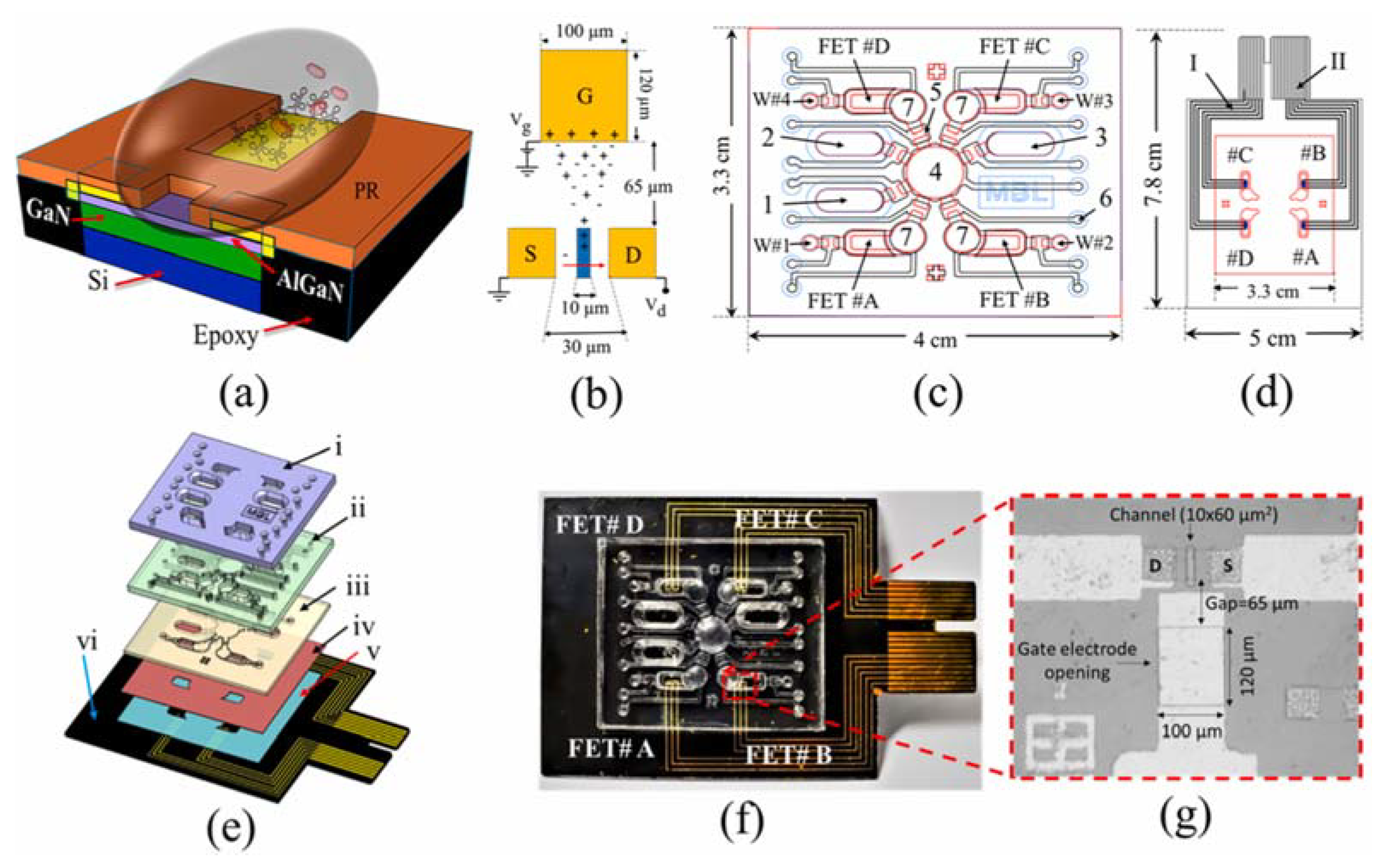
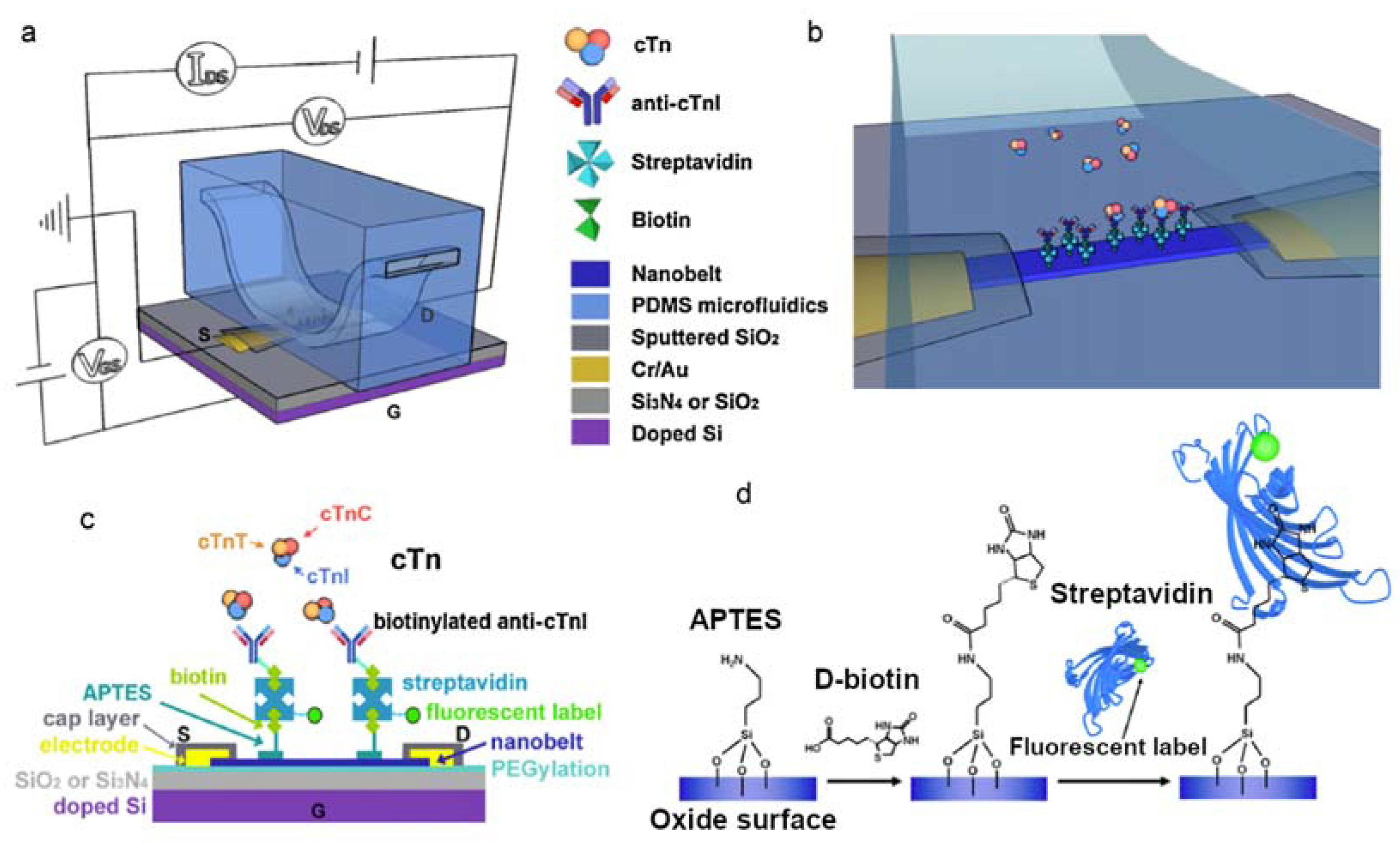
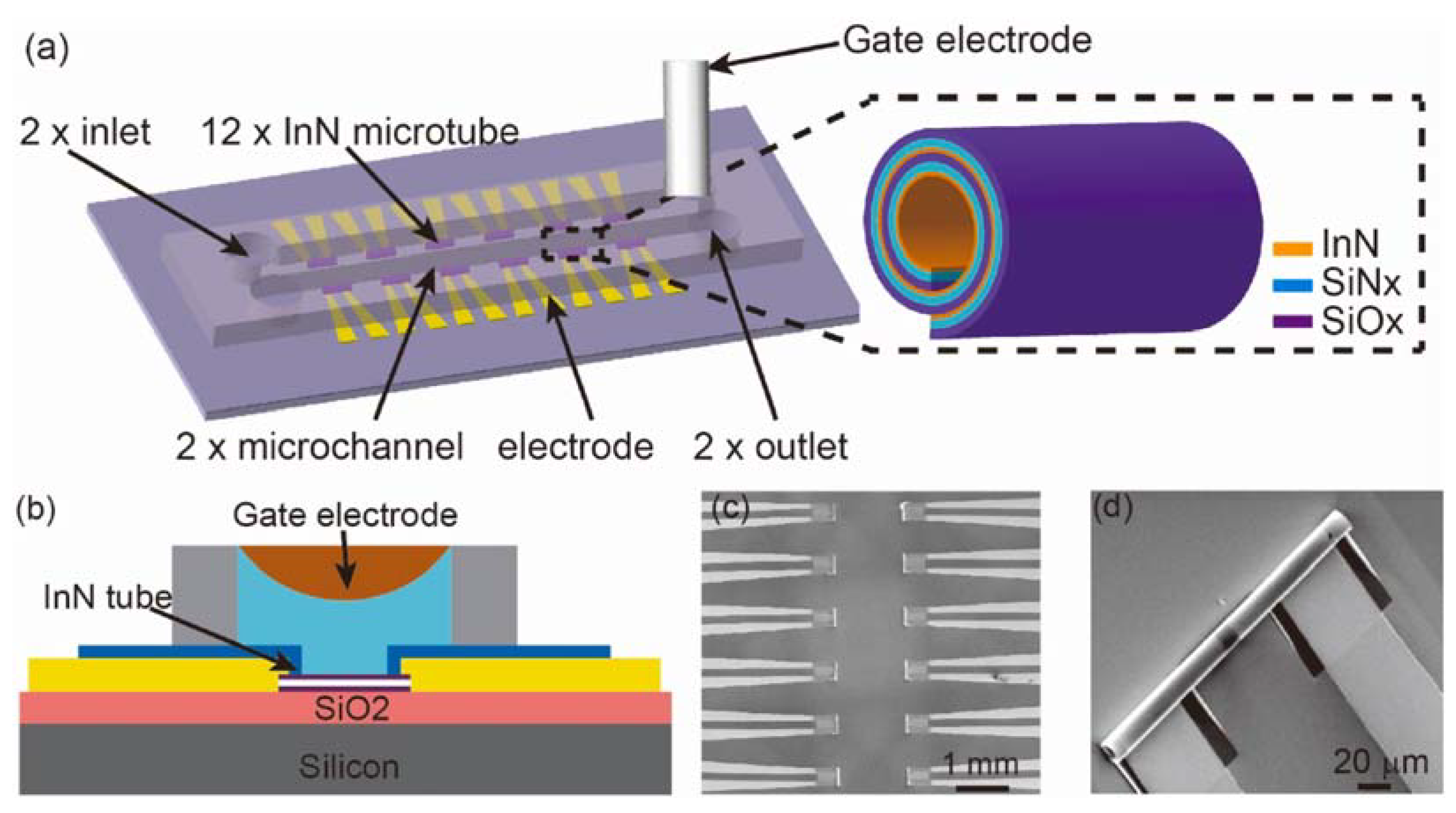

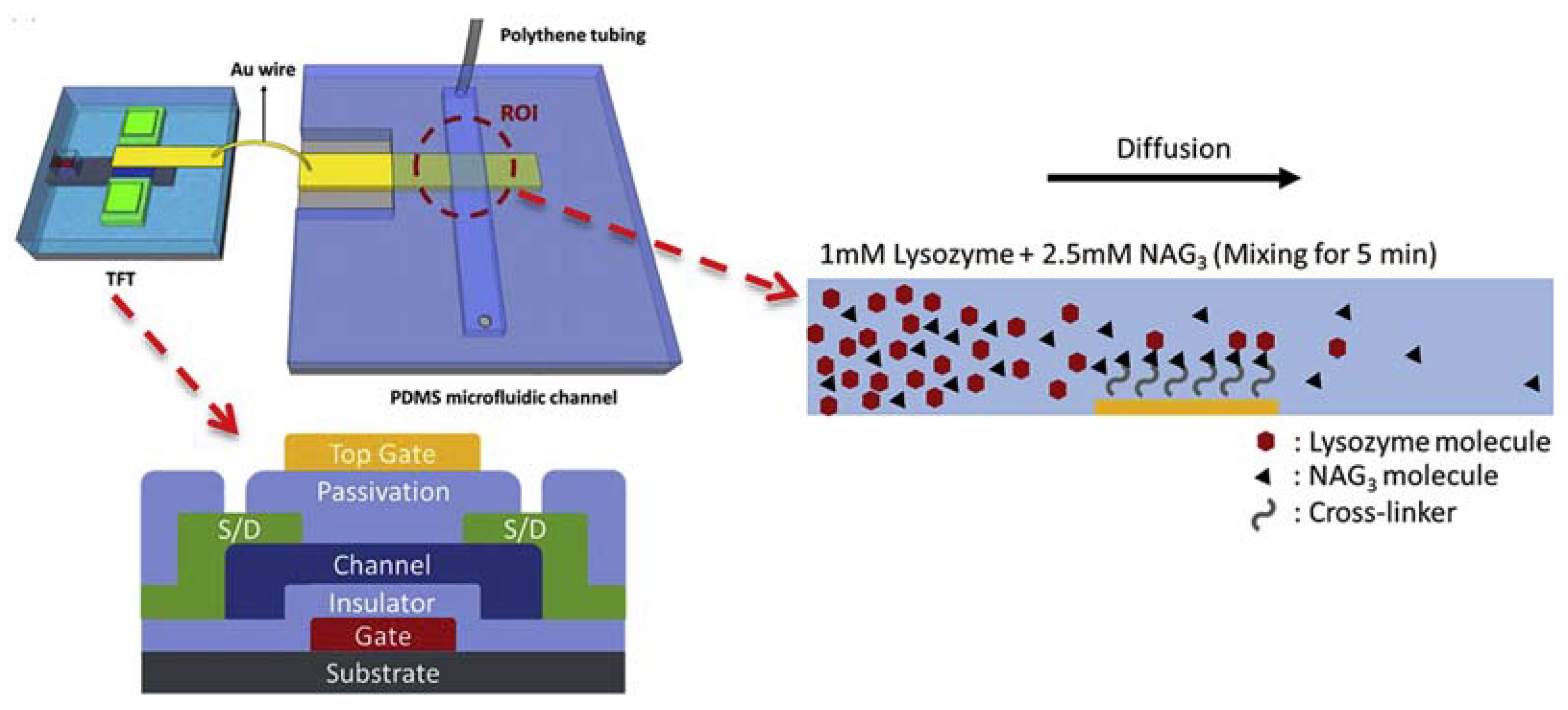


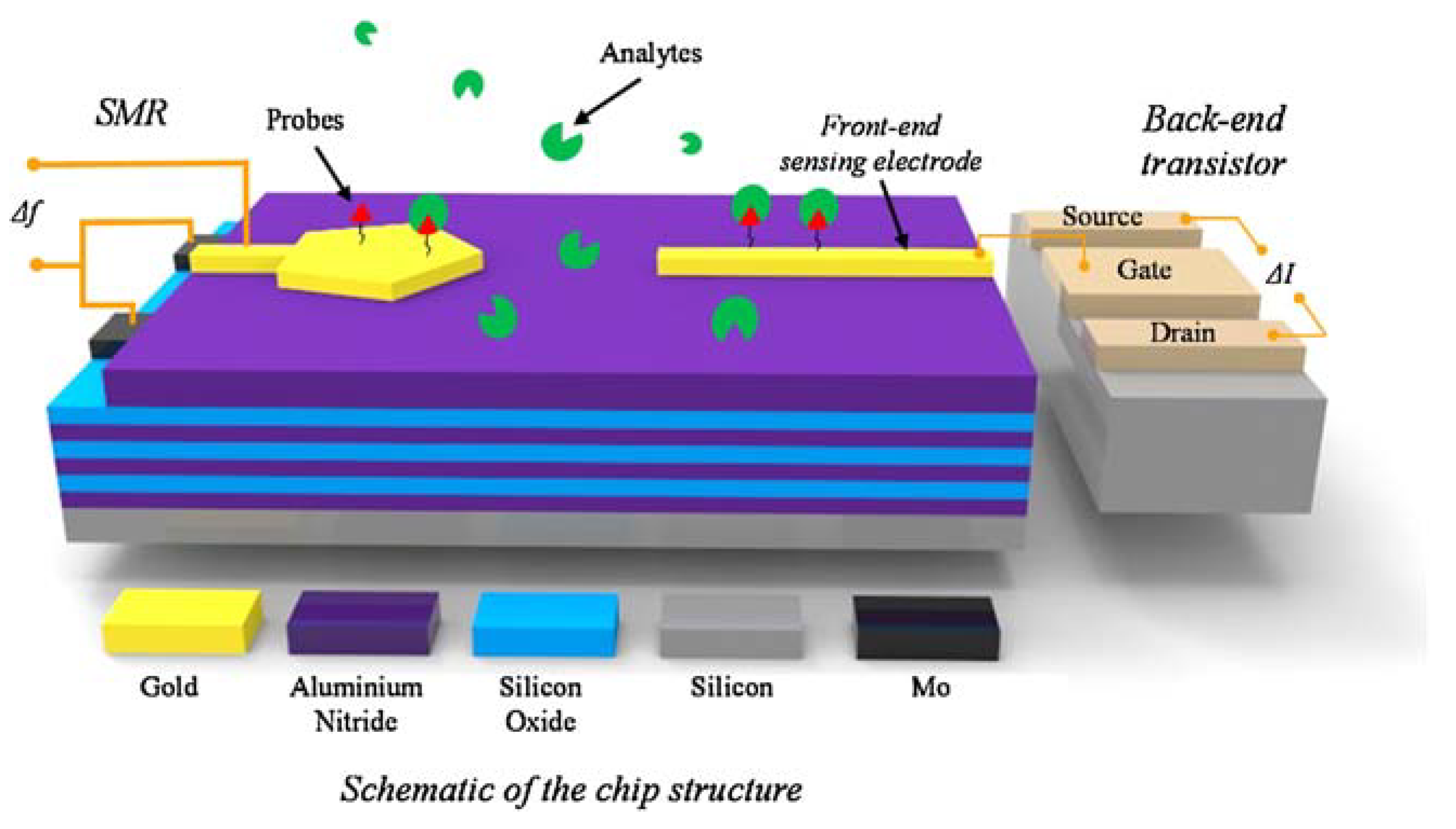

Disclaimer/Publisher’s Note: The statements, opinions and data contained in all publications are solely those of the individual author(s) and contributor(s) and not of MDPI and/or the editor(s). MDPI and/or the editor(s) disclaim responsibility for any injury to people or property resulting from any ideas, methods, instructions or products referred to in the content. |
© 2023 by the authors. Licensee MDPI, Basel, Switzerland. This article is an open access article distributed under the terms and conditions of the Creative Commons Attribution (CC BY) license (https://creativecommons.org/licenses/by/4.0/).
Share and Cite
Oliveira, D.C.d.B.; Costa, F.H.M.; da Silva, J.A.F. The Integration of Field Effect Transistors to Microfluidic Devices. Micromachines 2023, 14, 791. https://doi.org/10.3390/mi14040791
Oliveira DCdB, Costa FHM, da Silva JAF. The Integration of Field Effect Transistors to Microfluidic Devices. Micromachines. 2023; 14(4):791. https://doi.org/10.3390/mi14040791
Chicago/Turabian StyleOliveira, Dhaniella Cristhina de Brito, Fernando Henrique Marques Costa, and José Alberto Fracassi da Silva. 2023. "The Integration of Field Effect Transistors to Microfluidic Devices" Micromachines 14, no. 4: 791. https://doi.org/10.3390/mi14040791
APA StyleOliveira, D. C. d. B., Costa, F. H. M., & da Silva, J. A. F. (2023). The Integration of Field Effect Transistors to Microfluidic Devices. Micromachines, 14(4), 791. https://doi.org/10.3390/mi14040791





